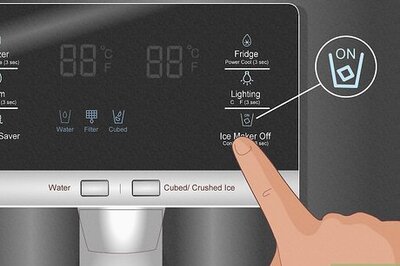
views
Soaking Off Polygel Nails
Cut down your nails with toenail or guillotine-style nail clippers. Use toenail clippers or guillotine nail clippers to trim off the excess polygel that extends past your natural nails. Cutting the nail down to the length of your natural nails or just past your fingertip makes removing the polygel much easier because there’s less product to dissolve. When using toenail clippers, clip on each side of the fingernail, then gently wiggle the nail tip back and forth until it breaks off. Po
File the top coat down with a nail file or e-file. Removing the product's top coat or surface layer with a file helps the acetone penetrate the polygel. This speeds up the time your nails must soak in acetone to dissolve the polygel. Use a coarse 100-grit nail file or a 180-grit sanding band on your electric file (e-file). Don’t use heavy pressure when filing. Light strokes with a coarse grit remove the top layer quickly.
Soften or dissolve the polygel by soaking your nails in acetone. The easiest way to soak off polygel nails is by pouring acetone into a glass bowl and soaking your nails in it for 10-15 minutes. To dissolve the polygel faster, soak a cotton ball with acetone and press it against your nail. Then, wrap a 3” x 3” square of aluminum foil around your finger to hold the cotton against your nail. Repeat on each nail, then wait 10-15 minutes. For extra secure wraps, use a set of nail clips to secure the aluminum.
Gently scrape away the loosened polygel with a cuticle pusher. After soaking for about 10 minutes, gently scrape one of your nails with a cuticle pusher or orange stick. If the polygel comes off easily, scrape the product off your nails. If it’s still too hard to remove without rough scraping, continue to soak in acetone for another 10 minutes before trying again. Repeat as many times as necessary until the polygel is soft. 100% acetone usually works more quickly than 90% acetone products, so you may need additional time when using the lower concentration. Using aluminum foil to seal in heat helps dissolve the polygel more quickly.
Buff away any excess residue with a buffing block or nail file. If there’s still polygel residue on your nails, use a medium or fine-grit nail file or 180-grit buffing block to lightly buff the nail clean. Only buff your nails to remove the residue. Over-buffing weakens your nails and can cause splits, breaks, or other damage.
Wash your hands with soap and water then moisturize. Acetone can dry out skin, cuticles, and nails. When you’ve removed the polygel product from your nails, give them a good wash with soal and warm water. After drying them off, apply cuticle oil and hand lotion to help restore moisture.
Filing Off Polygel Nails
Remove the nail tips and file off all but a thin layer of polygel. After clipping off the excess length, use a 100-grit nail file to remove as much of the polygel as possible. To speed up the process, use your e-file on low-to-medium speed with the coarse barrel bit that came with the e-file set. No matter which file you choose, use light strokes moving in one direction. When using the e-file, be careful only to remove polygel. Stop to check your progress often and leave a thin layer of polygel to avoid damaging your natural nails. Avoid using the coarse bit on your natural nail, as it may cause damage. Too much speed or pressure can cause heat spikes when using an e-file.
Gently buff or file the final layer of polygel from your nails. Remove the final thin layer of polygel with a fine-grit buffing block or nail file. Using nail file or buffing block with 180-280 grit makes it easier to remove the polygel without damaging your natural nails because it removes less product with each swipe. Use a brush to remove any excess powder created by filing.
Frequently Asked Questions
Do polygel nails damage your nails? The polygel product doesn’t damage your nails. However, improper application or removal can harm your natural nails. Nails that are over-buffed or over-filed while preparing them for applying or removing the polygel product with a file can weaken the nail, making it thin or brittle. Always take extra care to protect your natural nails when applying and removing polygel at home.
Can you remove polygels with water, dish soap, and oil? Some have found that warm water, with a squirt of dish soap and a drizzle of olive oil, can loosen polygel nails enough to remove them. This is usually only effective if your polygel is grown out and you’re already seeing some lifting of the product off the nail. This method may also cause damage to your nailbeds.
Does rubbing alcohol remove polygel? Rubbing alcohol will not remove cured polygel. However, isopropyl alcohol or slip solution prevents uncured polygel from sticking to the brush during application. Slip solution can also weaken the final polygel nail if too much of it mixes with the uncured product.
Do polygel nails break easily? Polygel nails are stronger than gel polish and more flexible than acrylics, so they can withstand more wear and tear. Polygels are an especially good choice for soft nails because their strength and durability protect the nail and prevent it from bending while it grows out.
What are the benefits of polygels over acrylics? Polygel manicures are lighter and more comfortable to wear than acrylic nails while offering similar durability. They also don’t have the strong odor associated with acrylic nails. Because they must be cured with a UV light to harden, nail techs have more time to create 3-dimensional designs. Polygels are easier to DIY than acrylic nails because you don’t have to mix the product to create your nails. Filing and shaping polygels is quicker and easier than acrylics due to the product’s flexibility.


















Comments
0 comment